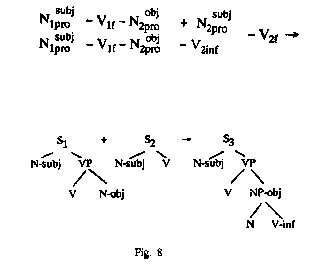
132
He turned to the waiter. + The waiter stood in the door. > He turned to the waiter who stood in the door.
These transitional relations are implicitly inherent in the syntagmatic classificational study of sentences. But
modern theory, exposing them explicitly, has made a cardinal step forward in so far as it has interpreted them as
regular derivation stages comparable to categorial form-making processes in morphology and word-building.
And it is on these lines that the initial, basic clement of syntactic derivation has been found, i.e. a syntactic
unit serving as a "sentence-root" and providing an objective ground for identifying syntactic categorial
oppositions. This element is known by different names, such as the "basic syntactic pattern", the "structural
sentence scheme", the "elementary sentence model", the "base sentence", though as the handiest in linguistic
use should be considered the "kernel sentence" due to its terminological flexibility combined with a natural
individualizing force.
Structurally the kernel sentence coincides with the elementary sentence described in the previous chapter.
The difference is, that the pattern of the kernel sentence is interpreted as forming the base of a paradigmatic
derivation in the corresponding sentence pattern series.
Thus, syntactic derivation should not be understood as an immediate change of one sentence into another
one; a pronounced or written sentence is a finished utterance that thereby cannot undergo any changes.
Syntactic derivation is to be understood as paradigmatic production of more complex pattern constructions out
of kernel pattern constructions as their structural bases. The description of this production ("generation") may
be more detailed and less detailed, i.e. it can be effected in more generalized and less generalized terms,
depending on the aim of the scholar. The most concrete presentation concerns a given speech utterance
analysed into its derivation history on the level of the word-forms.
By way of example let us take the following English sentence: I saw him come.
This sentence is described in scholar grammar as a sentence with a complex object, which is
syntagmatically adequate, though incomplete from the systemic point of view. The syntagmatic description is
supplemented and re-interpreted within the framework of the paradigmatic description presenting the sentence
in question as produced from the two kernel sentences: I saw him. + He came. > I saw him come.
In a more generalized, categorial-oriented paradigmatic presentation the sentence will be shown as a
transformational combination of the two kernel pattern-formulas:
The same may be given in terms of the IC-derivation tree diagrams (see Fig. 8). The indices specifying the
basic symbols can vary in accord with the concrete needs of analysis and demonstration.
§ 3. The derivation of genuine sentences lying on the "surface" of speech out of kernel sentences lying in the
"deep base" of speech can be analysed as a process falling into sets of elementary transformational steps or
procedures. These procedures make up six major classes.
The first class includes steps of "morphological arrangement" of the sentence, i.e. morphological changes
expressing syntactically relevant categories, above all, the predicative categories of the finite verb: tense,
aspect, voice, mood. The syntactic role of these forms of morphological change (systematized into
morphological paradigms) consists in the fact that they make up parts of the more general syntactico-
paradigmatic series. E.g.:
John + start (the kernel base string) >John starts. John will be starting. John would be starting. John has
started. Etc.
The second class of the described procedures includes various uses of functional words (functional
expansion). From the syntactic point of view these words are transformers of syntactic constructions in the
same sense as the categorial morphemes (e.g. inflexions) are transformers of lexemes, i.e. morphological
constructions. E.g.:

